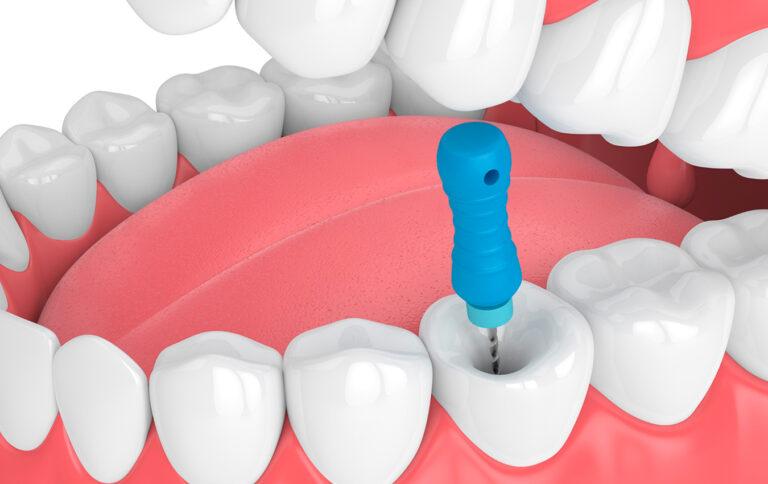Being Professor and Head Of the Department of Endodontics and Conservative Dentistry.
I, Dr. Manish and my team is well versed with root canals, multiple root canals in single sitting, post and core build up, esthetics, corrections and much more.
We at Aashu Dental use state of art equipments like rotary endodontics, crown down method, protaper system, radiovisuography to envision modern root canals in a much better perspective.
I would like you to visit us and take on a first hand experience in case of any dental treatment required by you and your relatives.
What is Single-Sitting RCT Procedure ?
When there is an acute infection with no pus accumalation in & around the tooth, Root canal treatment can be completed in a single sitting. The biggest diagnostic aid in this case is an X-ray. Which shows presence or absence of pus accumalation in the form of a Periapical Radioluency.
X Ray shows Periapical Radioluency.
The Procedure :-
1.First step is to open the pulp chamber to allow access to the canals.
2.Once open, with help of special instruments known as rotary files the infected nerves is removed. The
canals are flushed with antiseptic solution.
3.The root canals are further cleaned & reshaped to free them of all debris with rotary instrument.
4.Once the canals are empty dry & clean, they are filled and sealed with biocompatible material
known as Gutta Purcha Points / G.P. Points
5.The cavity is then filled with temporarily filling material which is then replaced with a permanent
filling material like composite filling.
6.A root canal treated tooth should be ideally capped after 15-20 days.
Root Canal Treatment (RCT)
Benefits
- Root Canal Treatment(RCT) aims to create an end result where the tissue surrounding the root will continue to be healthy despite the degenerative changes that were undergone by the tooth root.
- Root Canal Treatment(RCT) provides the bulk of the clean up work for the body by removing bacteria and tissue irritants that are present inside the tooth.
Who is this procedure for?
- Patients whose tooth nerve tissue has started to degenerate
- Patients with teeth that are causing pain
- Patients with recurring pimples on their gums
- Patients who experience the exposure of a tooth nerve
- Patients with acute tooth abscess.
How long does root canal treatment take?
The total amount of appointment time that will be required for your root canal treatment can hinge on a number of factors. Some of these are:
- Different teeth have differing numbers of root canals, each of which need to be located, cleaned, and sealed. As an example, front teeth typically just have a single root canal while molars often have three or more canals.
- Will your root canal treatment be completed in just one sitting or will the process be broken up into two appointments? At times a dentist will feel it is best to clean out a tooth during an initial visit and then have you return for a second appointment when they will seal up the interior of your tooth. Equally commonplace, a dentist may feel that it is preferable to perform both tasks during the same appointment.[ More about why just one or possibly more visits might be needed to complete your root canal treatment.]
You will have to ask your Dentist in Ahmedabad what amount of time is needed for your treatment. As a ballpark estimate however, it seems likely that any single appointment will last somewhere between 30 to 60 minutes and in some cases possibly as long as 90 minutes.
What happens before the procedure?
Root Canal Treatment(RCT) is only performed on numbed teeth. This helps ease the pain and the patient is more relaxed. Once the tooth is numbed, the dentist stretches a sheet of rubber around the tooth. It acts like a dam that keeps the saliva uncontaminated with bacteria while the procedure is being performed.
What happens during the procedure?
The dentist then uses a drill to gain access to the area inside the tooth where the nerve is. A hole is made inside the tooth, down to the pulp chamber. Next, the dentist cleans the pulp chamber and all root canals using instruments that look like small pins – the “root canal files”. The dentist uses the root canal files in an up – and – down twisting motion. This scrapes and scrubs the root canal, cleaning it of debris and bacteria. Periodically the dentist also washes out the tooth to flush away the remaining debris.
Once the tooth is cleaned the dentist uses root canal filling material to fill in and seal up the interior. Some dentists choose to do this on the same day as the root canal treatment, while others choose to wait for about a week. In this case they will use a temporary filling to keep contaminates out until the permanent filling is placed.
What happens after the procedure?
It is very likely that patients will feel their teeth a bit tender after the procedure. Sensitivity is minimized by the use of analgesic and anti – inflammatory medicine. The dentist will instruct the patients on how to chew on the treated teeth.

